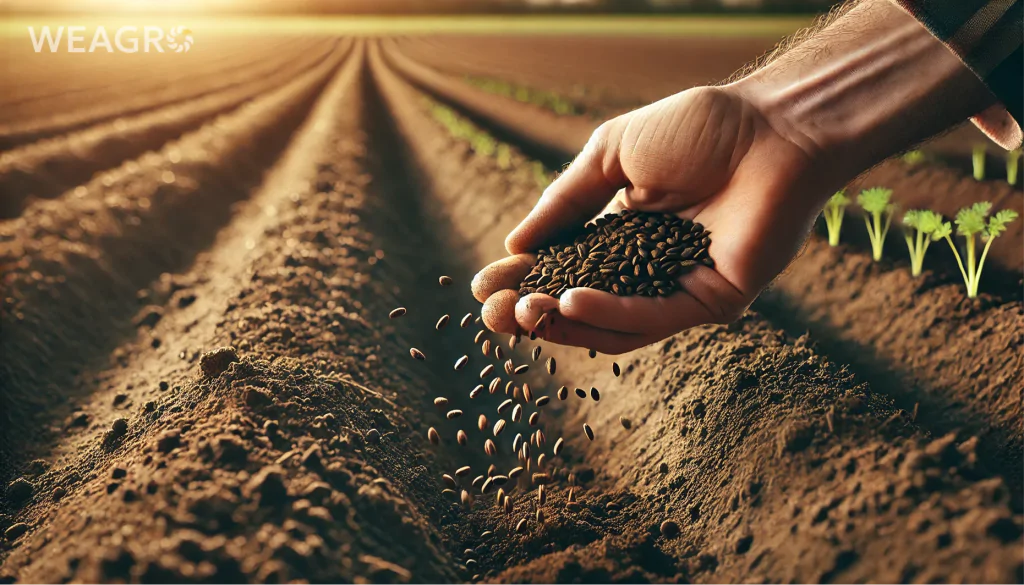Carrots are one of the most popular vegetable crops in Ukraine. In 2023, according to the State Statistics Service, the carrot harvest in Ukraine amounted to 844.4 thousand tons, which is 12.8% more compared to the previous year. This article will be useful for farmers who grow crops in open ground for sale. We will explain when to sow carrots in spring, which varieties are suitable depending on the region of Ukraine, how to properly prepare the soil and care for the crops.
When to Sow Carrots in Spring

Spring sowing dates depend on the climatic conditions of the region. In the southern regions of Ukraine, root crops can be sown as early as late March – early April, when the soil warms up to 5-7°C. In the central and northern regions, the optimal time to sow early carrots is mid to late April.
It is important to consider not only calendar dates, but also the actual condition of the soil. If spring is prolonged and cold, it is better to wait until the soil warms up sufficiently and dries out. Sowing carrots in wet and cold soil is not recommended – this can lead to seed rot and thinning of seedlings.
To determine the optimal dates when carrots can be sown in spring in a specific region, you can use long-term phenological data. For example, in Polissia, carrots are usually sown after alder flowering, in the Forest-Steppe – after dandelion flowering, and in the Steppe – after the full opening of apricot leaves.
When choosing dates, you should also consider the characteristics of the variety. Early varieties germinate faster and can better withstand short-term cold spells. Mid-season and late varieties require warmer soil and stable weather.
Another factor that affects sowing dates is the sowing method. With direct seeding, root crops are sown in open ground at earlier dates.
Read also: Sugar Beet: Sowing, Yield, Varieties, and Diseases
Early Carrot Varieties
Early carrot varieties that mature 70-90 days after germination are suitable for spring sowing. They have a compact root system and grow well even in cool conditions. Let’s consider some popular early carrot varieties that can be grown in different regions of Ukraine.
Amsterdam
Dutch early carrot variety. Root crops are conical in shape, bright orange in color, weighing 100-180 g. The flesh is juicy, sweet, tender. The variety is characterized by uniform yield return, good storage and transportability. Suitable for growing in open ground in all regions of Ukraine.
Growing features:
- vegetation period: 75-90 days;
- sown in late April – early May;
- seeding rate is 1-1.2 million pcs/ha;
- seed covering depth: 2-3 cm;
- row spacing: 20-25 cm;
- harvest from mid-July.
Due to its compact size and high quality root crops, the variety is in demand in the fresh produce market. It is especially valued for uniform ripening and the possibility of long-term storage.
Nantes 4
French variety with a vegetation period of 70-90 days. Root crops are cylindrical, 14-16 cm long, weighing up to 150 g. The flesh is uniform, without core, with high content of carotene and sugars. The variety is undemanding to growing conditions and gives stable yields. Recommended for Polissia and Forest-Steppe of Ukraine.
Growing features:
- sown in late April – early May;
- seeding rate: 0.8-1 million pcs/ha;
- seed covering depth: 2-3 cm;
- row spacing: 45 cm;
- harvest from late June.
Nantes 4 remains one of the most popular varieties in Ukraine due to its excellent taste qualities and versatility of use. Its cylindrical shape and absence of core make the variety ideal for processing and fresh consumption.
Chantenay 2461
Early-maturing variety with a vegetation period of 65-75 days. Root crops are conical with a slightly pointed tip, 10-15 cm long. The flesh is bright orange, sweet, aromatic. The variety is resistant to bolting, suitable for mechanized harvesting. Grows well in all zones of Ukraine.
Growing features:
- sown from mid-April;
- seeding rate: 1.2-1.5 million pcs/ha;
- seed covering depth: 2-3 cm;
- row spacing: 20-45 cm;
- harvested from mid-June.
Chantenay 2461 is an optimal choice for obtaining ultra-early harvest. Due to its short vegetation period and resistance to mechanical damage, the variety is widely used in industrial production and home gardens.
Laguna F1
Dutch early hybrid. Period from germination to technical maturity – 85-95 days. Root crops are cylindrical, 18-22 cm long, weighing 120-200 g. The flesh is dense, juicy, with sugar content up to 9%. The hybrid is resistant to alternaria dauci and cercospora carotae. Suitable for growing in Forest-Steppe and Polissia.
Features:
- sown from late April to mid-May;
- seeding rate: 0.8-1 million pcs/ha;
- seed covering depth: 1.5-2 cm;
- row spacing: 45 cm;
- harvest from mid-July.
Due to its resistance to major diseases and high product yield, the hybrid is economically viable for large-scale production.
Cardiff F1
Early hybrid from Bejo Zaden. Matures 85-95 days after germination. Root crops are cylindrical, uniform, without core, of rich orange color. Marketable weight 120-180 g. Hybrid with high content of carotene and sugars, resistant to cracking. Well suited for obtaining early bunched produce.
Growing features:
- sown from late April to mid-May;
- seeding rate: 1-1.2 million pcs/ha;
- seed covering depth: 2-3 cm;
- row spacing: 20-45 cm;
- harvest from early July.
Cardiff F1 is a promising hybrid for farmers focused on the early fresh produce market. High uniformity of root crops and excellent taste qualities ensure stable demand and profitability of cultivation. The hybrid is especially valuable in bunched produce production.
To obtain early produce, it is better to prefer pelleted and calibrated seeds. The former has a polymer coating with additives that facilitates precise sowing and promotes rapid germination, while the latter has uniform size and equal weight, ensuring uniform emergence.
Early Carrot Growing Technology

To obtain quality results from spring carrot planting, it is important to properly prepare the soil, choose the optimal sowing method and provide plants with necessary care. Let’s consider the main stages of early carrot growing technology in more detail.
Early Carrots: Growing Conditions
The crop grows best on light sandy loam and loamy soils with neutral reaction (pH 6.5-7). Heavy clay soils are less suitable, as root crops become deformed, with cracks and growths.
To ensure normal development, plenty of light and moderate moisture are needed. Optimal growth temperature is 16-25°C. Below 15°C, the process slows down, root crops become less sweet.
The crop responds well to organic fertilizer application – manure, compost, green manures. They improve soil structure, increase its fertility and water-holding capacity. Nitrogen fertilizers are better not to use, as they worsen taste and storage quality of root crops.
For spring carrot sowing, areas with fertile, structured soil are chosen, on southern or southwestern slopes that are well warmed by the sun. Groundwater level should be no higher than 1.5-2 m.
The crop is not recommended to be grown after other root crops, as they deplete the soil and accumulate common pests and diseases. Also, crops should not be placed near umbelliferous plants – dill, parsley, celery, parsnip. They can cross-pollinate with root crops and reduce their quality.
Early Carrots: Sowing
Successful cultivation begins with proper early carrot sowing and soil preparation. This root crop is particularly demanding of soil structure and quality, so the work requires attention and thoroughness.
Soil Preparation for Carrot Sowing
The area is prepared in autumn. It is dug to a depth of 25-30 cm, simultaneously applying organic fertilizers – 4-6 kg/m² of rotted manure or compost. In spring, the soil is loosened to a depth of 10-12 cm, leveled and rolled.
If autumn soil preparation could not be carried out, it is performed in spring, 2-3 weeks before sowing. First, the area is cleared of weeds and plant residues, then loosened, fertilizers are applied and the surface is leveled.
Before sowing carrots in spring, the soil is thoroughly loosened and beds are formed. For this, a walk-behind tractor with attachment or cultivator is used. Bed width is 1-1.2 m, height is 15-20 cm. Paths 40-50 cm wide are left between beds.
Preparation of large soil areas is carried out using combined units that loosen, level and roll the soil in one pass. This allows faster and better field cultivation before sowing.
Purchasing quality seed material, organic fertilizers and soil cultivation equipment on favorable terms is facilitated by agricultural installments WEAGRO, which allows farmers to buy goods and services with deferred payment.
Carrot Predecessors
The best predecessors for carrots are cereals, legumes, potatoes, cabbage, onions. It is not recommended to sow root crops after celery, parsley, parsnip, as they have common pests and diseases. The crop can be returned no earlier than 3-4 years.
Carrot Sowing Methods
There are two methods for properly sowing carrots in spring:
- row sowing (row spacing is 45 cm);
- band sowing (bands of 3-4 rows spaced 20 cm apart, inter-band space is 50-70 cm).
Band sowing allows more rational use of area, facilitates crop care and harvesting. Seeds are sown to a depth of 2-3 cm with a seeding rate of 0.8-1.2 million pcs/ha for row sowing and 1-1.5 million pcs/ha for band sowing.
Sowing of small areas is done manually using a marker. For fields, precision seeders are used that ensure uniform seed distribution and optimal density.
The material should preferably be calibrated, selecting large and uniform fractions. This will improve germination and facilitate mechanized crop care. To ensure precise sowing, pelleted seeds in coating can be used, which do not stick together and easily pass through seeding units.
After completion, the soil is rolled with ring-spur rollers, which improves seed contact with soil. If necessary, crops are mulched with peat or humus in a 0.5-1 cm layer.
To accelerate seedling emergence and protect against late frosts, early sowings are covered with agro-fabric or perforated film. After seedling emergence, covers are removed.
Read also: Precision Farming in Ukraine: Definition and Prospects
Carrot Care
Main care measures include weeding, inter-row cultivation, thinning, pest and disease control. Weeding and cultivation are carried out 8-12 days after seedling emergence and repeated every 2 weeks.
Inter-row cultivation improves air and water regime of soil, stimulates root growth. It is carried out to a depth of 5-8 cm with cultivators or walk-behind tractors. Simultaneously with cultivation, fertilizers are applied and plants are watered.
Seedling thinning is done at the 2-3 true leaf stage, when plants reach 5-7 cm height. Optimal plant density is 30-40 pcs/m for row sowing and 40-50 pcs/m for band sowing. Excess plants are removed, leaving the most developed specimens in the row at a distance of 4-5 cm from each other.
Root crops are regularly watered, especially during formation period. Irrigation rate is 250-300 m³/ha. Watering is done in the morning or evening, avoiding water contact with leaves. On light soils, watering is done more frequently with small rates, on heavy soils – less frequently but more abundantly.
To increase yield and quality of root crops, they are fed 2-3 times per season with complex fertilizers. First feeding is done 2 weeks after emergence, second – after a month, third – after 2 months. From organic fertilizers, liquid manure, bird droppings, biohumus are used. They are diluted with water in a 1:10 ratio and watered at the root at a rate of 0.5-1 l per 1 m².
For protection against pests (carrot fly, aphids, thrips), biological preparations are used – actofit, fitoverm, bitoxibacillin. Treatments are carried out at the first signs of damage with 7-10 day intervals.
Carrot Harvesting and Storage
Early carrot varieties are harvested when root crops reach the required size – 70-90 days after emergence. Harvesting is done selectively, as they ripen. Yield of early varieties is 30-50 t/ha, hybrids – 40-80 t/ha.
Harvested crops are cleaned of soil and tops, sorted by size. Undamaged, dry root crops are suitable for long-term storage. They are kept in boxes or containers at 0-1°C temperature and 90-95% air humidity. Under such conditions, root crops can be stored until the next season.
Conclusion
Early varieties have good potential for cultivation in Ukraine. They allow obtaining quality harvest as early as June-July, which unloads storage facilities and provides opportunity to sell produce at favorable prices.
For successful cultivation, it is important to follow optimal dates for your region, use quality seeds, properly prepare soil and care for crops. Modern precision farming technologies, moisture sensors, field monitoring systems help control growing conditions and respond timely to plant needs. This allows reducing resource costs and obtaining stable yields without using harmful chemicals.
Farmers who grow carrots for sale can take advantage of the online service WEAGRO. It allows purchasing seeds, fertilizers, equipment in installments with harvest payment, without unnecessary intermediaries. This will help optimize costs, increase production profitability and expand sales markets.









